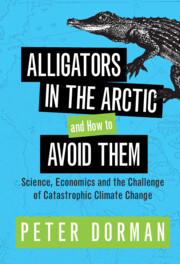 Alligators in the Arctic and How to Avoid Them
Alligators in the Arctic and How to Avoid Them Book contents
- Alligators in the Arctic and How to Avoid Them
- Alligators in the Arctic and How to Avoid Them
- Copyright page
- Dedication
- Contents
- Figures, Maps and Tables
- Preface
- Introduction
- 1 Carbon Accounting for Planet Earth
- 2 The Risks of Climate Change, or Why Carbon Budgets Need to Be Binding
- 3 Measurement
- 4 It’s about Fossil Fuels
- 5 Costs and Consequences
- 6 The Carbon Policy Toolkit
- 7 The Global Dimension
- 8 Political Economy for Alligators
- Appendix: Demystifying the Economics of Climate Change
- Notes
- References
- Index
2 - The Risks of Climate Change, or Why Carbon Budgets Need to Be Binding
Published online by Cambridge University Press: 14 July 2022
- Alligators in the Arctic and How to Avoid Them
- Alligators in the Arctic and How to Avoid Them
- Copyright page
- Dedication
- Contents
- Figures, Maps and Tables
- Preface
- Introduction
- 1 Carbon Accounting for Planet Earth
- 2 The Risks of Climate Change, or Why Carbon Budgets Need to Be Binding
- 3 Measurement
- 4 It’s about Fossil Fuels
- 5 Costs and Consequences
- 6 The Carbon Policy Toolkit
- 7 The Global Dimension
- 8 Political Economy for Alligators
- Appendix: Demystifying the Economics of Climate Change
- Notes
- References
- Index
Summary
Climate change presents two types of risks: those we can adapt to or try to counteract and those beyond our power to cope. The first group includes (1) sea level rise, which threatens much of our infrastructure and cultural patrimony; (2) extreme weather, particularly storm events; (3) climate alterations harmful to agriculture; (4) loss of biodiversity; (5) ocean acidification that interferes with shell production and threatens marine food chains; and (6) threats to human health from disease and especially extreme heat. The second group, which encompasses an unmanageable intensification of all of the first, is the risk of runaway climate change. This can arise if elevated atmospheric carbon concentrations trigger positive feedback mechanisms, like stored methane releases, widespread forest die-offs, reduction of the Earth’s albedo, or changes in prevalent cloud formations that amplify initial warming effects, resulting in a “hothouse Earth.” The tools of standard welfare economics, like calculation of a social cost of carbon and its use in cost–benefit analysis, are unhelpful. Their basis in marginal effects is contradicted by the scale of climate impacts, and their deference to consumer judgment tells us little about the political judgments that must guide policy trade-offs.
Keywords
- Type
- Chapter
- Information
- Alligators in the Arctic and How to Avoid ThemScience, Economics and the Challenge of Catastrophic Climate Change, pp. 37 - 52Publisher: Cambridge University PressPrint publication year: 2022


